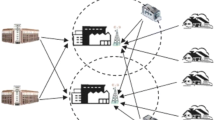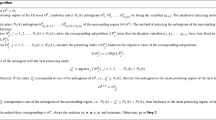Abstract
Emergency transportation is the most important part of disaster relief supply chain operations, and its planning problem always involves multiple objectives, complex constraints, and inherent uncertainty. Based on the analysis of several natural disaster that occurred in China since 2007, we propose a multi-objective fuzzy optimization problem of emergency transportation planning in disaster relief supply chains, which takes into consideration three transportation modes: air, rail, and road. To cope with the uncertainty, we employ three correlated fuzzy ranking criteria, and define the β dominance relation for evaluating the solutions of the problem. To efficiently solve the problem, we develop a cooperative optimization method that divides the integrated problem into a set of subcomponents, evolves the sub-solutions concurrently, and brings together the sub-solutions to construct complete solutions. The proposed method is effective, scalable, and robust, and thus contributes greatly to the performance of emergency transportation planning in disaster management.








Similar content being viewed by others
Notes
If a vehicle has to pass through an edge more than once, then each time it is included into V(e) as a distinct element.
References
Altay N, Walter GG (2006) OR/MS research in disaster operations management. Eur J Oper Res 175:475–493. doi:10.1016/j.ejor.2005.05.016
Beraldi P, Bruni ME (2009) A probabilistic model applied to emergency service vehicle location. Eur J Oper Res 196: 323–331. doi:10.1016/j.ejor.2008.02.027
Bozorgi-Amiri A, Jabalameli MS, Mirzapour Al-e-Hashem SMJ (2011) A multi-objective robust stochastic programming model for disaster relief logistics under uncertainty. OR Spectr. doi:10.1007/s00291-011-0268-x
Bozorgi-Amiri A, Jabalameli MS, Alinaghian M, Heydari M (2012) A modified particle swarm optimization for disaster relief logistics under uncertain environment. Int J Adv Manuf Tech 60:357–371. doi:10.1007/s00170-011-3596-8
Bruno JL, Coffman EG, Sethi R (1974) Scheduling independent tasks to reduce mean finishing time. Commun ACM 17:382–387
Caccetta L, Dzator M (2005) Heuristic methods for locating emergency facilities. In: Proceeding of 16th international congress on modelling and simulation, pp 1744–1750
Cai Y, Qian J, Sun Y (1997) Complexity of multiple demands vehicle routing problems. Oper Manag 6:1–5
Chai G, Fang C, Gao X, Zhao Q (2011) A cost-based study on highway traffic emergency rescue sites location using heuristic genetic algorithm. J Comput Info Syst 7:507–514
Chen SY, Zheng YJ, Cattani C, Wang WL (2012) Modeling of biological intelligence for SCM system optimization. Comput Math Method Med. doi:10.1016/j.ejor.2008.02.027
Chern CC, Chen YL, Kung LC (2010) A heuristic relief transportation planning algorithm for emergency supply chain management. Int J Comput Math 87:1638–1664. doi:10.1080/00207160802441256
Da S, Shen H, Liu H (2007) Research on case-based reasoning combined with rule-based reasoning for emergency. In: Proceedings of IEEE international conference on service operations and logistics, and informatics, pp 1–5
Deb K, Pratap A, Agarwal S, Meyarivan T (2002) A fast and elitist multi-objective genetic algorithm: NSGA-II. IEEE Trans Evol Comput 6:182–197. doi:10.1109/4235.996017
Evers PT (2001) Heuristics for assessing emergency transshipments. Eur J Oper Res 129:311–316. doi:10.1016/S0377-2217(00)00228-9
Fiedrich F, Gehbauer F, Rickers U (2000) Optimized resource allocation for emergency response after earthquake disasters. Saf Sci 35:41–57. doi:10.1016/S0925-7535(00)00021-7
Gong W, Cai Z (2008) A multiobjective differential evolution algorithm for constrained optimization. In: Proceedings of IEEE congress on evolutionary computation, pp 181–188
Gu HY (2008) Application of immune algorithm in emergency logistics distribution VRP. Logist Sci Technol 31:24–27
Haghani A, Oh SC (1996) Formulation and solution of a multi-commodity, multi-modal network flow model for disaster relief operations. Transp Res Part A 30:231–250. doi:10.1016/0965-8564(95)00020-8
Haghani A, Afshar AM (2009) Supply chain management in disaster response. Final Project Report, Department of Civil and Environmental Engineering, University of Maryland
Hamacher HW, Hennes H (2007) Integrated scheduling and location models: single machine makespan problems. Stud Locat Anal 16:77–90
Han CF (2009) Genetic algorithm for solving problems in emergency management. In: Proceedings of 15th international conference on natural computation, Tianjin, China, 2009, pp 259–264
Hansen MP (2000) Tabu search for multiobjective combinatorial optimization: TAMOCO. Control Cybern 29:799–818
Inuiguchi M, Greco S, Slowinski R, Tanino T (2003) Possibility and necessity measure specification using modifiers for decision making under fuzziness. Fuzzy Set Syst 137:151–175. doi:10.1016/S0165-0114(02)00438-4
Kaur A, Kumar A (2012) A new approach for solving fuzzy transportation problems using generalized trapezoidal fuzzy numbers. Appl Soft Comput 12:1201–1213. doi:10.1016/j.asoc.2011.10.014
Laporte G (1992) The vehicle routing problem: an overview of exact and approximate algorithms. Eur J Oper Res 59:345–358. doi:10.1016/0377-2217(92)90192-C
Li X, Yao X (2009) Tackling high dimensional nonseparable optimization problems by cooperatively coevolving particle swarms. In: Proceedings of the IEEE congress on evolutionary computation, pp 1546–1553
Li YY, Xiang RR, Jiao LC, Liu RC (2012) An improved cooperative quantum-behaved particle swarm optimization. Soft Comput 16:1061–1069. doi:10.1007/s00500-012-0803-y
Lim KK, Ong YS, Lim MH, Chen X, Agarwal A (2008) Hybrid ant colony algorithms for path planning in sparse graphs. Soft Comput 12:981–994. doi:10.1007/s00500-007-0264-x
Lin YH, Batta R, Rogerson PA, Blatt A, Flanigan M (2009) A logistics model for delivery of critical items in a disaster relief operation: heuristic approaches. Working paper. http://www.acsu.buffalo.edu/batta/
Liu B (2007) Uncertainty theory, 2nd edn. Springer, Berlin
Minner S, Silver EA, Robb DJ (2003) An improved heuristic for deciding on emergency transshipments. Eur J Oper Res 148:384–400. doi:10.1016/S0377-2217(02)00424-1
Molina D, Lozano M, Sánchez AM, Herrera F (2011) Memetic algorithms based on local search chains for large scale continuous optimisation problems: MA-SSW-Chains. Soft Comput 15:2201–2220. doi:10.1007/s00500-010-0647-2
Nagy G, Salhi S (2007) Location-routing: issues, models and methods. Eur J Oper Res 177:649–672. doi:10.1016/j.ejor.2006.04.004
Ombuki B, Ross BJ, Hanshar F (2006) Multi-objective genetic algorithms for vehicle routing problem with time windows. Appl Intell 24:17–30. doi:10.1007/s10489-006-6926-z
Ozdamar L, Ekinci E, Küçükyazici B (2004) Emergency logistics planning in natural disasters. Ann Oper Res 129:217–245. doi:10.1023/B:ANOR.0000030690.27939.39
Pang H, Liu N, Wu Q (2012) Decision-making model for transportation and distribution of emergency materials and its modified particle swarm optimization algorithm. Control Decis 27:871–874
Parejo J, Ruiz-Corté A, Lozano S, Fernandez P (2012) Metaheuristic optimization frameworks: a survey and benchmarking. Soft Comput 16:527–561. doi:10.1007/s00500-011-0754-8
Parsopoulos KE (2012) Parallel cooperative micro-particle swarm optimization: a master–slave model. Appl Soft Comput 12:3552–3579. doi:10.1016/j.asoc.2012.07.013
Peng J, Xu W, Yang J (2009) A hybrid heuristic algorithm for large scale emergency logistics. In: Proceedings of 2nd international conference on intelligent computation technology and automation, pp 899–902
Potter MA, De Jong K (2000) Cooperative coevolution: an architecture for evolving coadapted subcomponents. Evol Comput 8:1–29
Prodanovic P, Simonovic SP (2003) Fuzzy compromise programming for group decision making. IEEE Trans Syst Man Cyber Part A 33:358–365. doi:10.1109/TSMCA.2003.817050
Ramli N, Mohamad D (2009) A comparative analysis of centroid methods in ranking fuzzy numbers. Eur J Sci Res 28:492–501
Rath S, Gutjahr WJ (2011) A math-heuristic for the warehouse location–routing problem in disaster relief. Comput Oper Res. doi:10.1016/j.cor.2011.07.016
Runarsson TP, Yao X (2005) Search biases in constrained evolutionary optimization. IEEE Trans Syst Man Cybern C 35:233–243. doi:10.1109/TSMCC.2004.841906
Sadjadi SJ, Pourmoayed R, Aryanezhad MB (2012) A robust critical path in an environment with hybrid uncertainty. Appl Soft Comput 12:1087–1100. doi:10.1016/j.asoc.2011.11.015
Santosa DS, Bazzanb ALC (2012) Distributed clustering for group formation and task allocation in multiagent systems: a swarm intelligence approach. Appl Soft Comput 12:2123–2131. doi:10.1016/j.asoc.2012.03.016
Tzeng GH, Cheng HJ, Huang TD (2007) Multi-objective optimal planning for designing relief delivery systems. Transp Res Part E 43:673–686. doi:10.1016/j.tre.2006.10.012
Wen M, Kang R (2011) Some optimal models for facility location–allocation problem with random fuzzy demands. Appl Soft Comput 11:1202–1207. doi:10.1016/j.asoc.2010.02.018
Xie B, Hu X (2009) A model and heuristic algorithm for inventory routing problem in emergency logistics. In: Proceedings of the 9th international conference of Chinese transportation professionals. doi:10.1061/41064(358)442
Yang L, Gao Z, Li K (2012) Railway freight transportation planning with mixed uncertainty of randomness and fuzziness. Appl Soft Comput 12:
Zadeh LA (1965) Fuzzy sets. Inform Control 8:338–353
Zhang Z (2007) Immune optimization algorithm for constrained nonlinear multiobjective optimization problems. Appl Soft Comput 7:840–857. doi:10.1016/j.asoc.2006.02.008
Zhang HL, Li XF, Wang RB (2010) Emergency resources distribution based on heuristic genetic algorithm. J Jilin Univ 40:758–762
Zheng YJ, Chen SY, Ling HF (2012) Agent-based cooperative evolutionary computation for disaster rescue operation planning. Disaster Adv 5:698–703
Zheng YJ, Ling HF, Chen SY (2012) Efficient multi-objective tabu search for emergency equipment maintenance scheduling in disaster rescue. Optim Lett. doi:10.1007/s11590-011-0397-9
Zitzler E, Deb K, Thiele L (2000) Comparison of multiobjective evolutionary algorithms: empirical results. Evol Comput 8:173–195. doi:10.1162/106365600568202
Acknowledgments
The work was partly supported by grants from National Natural Science Foundation (Grant No. 61105073, 61020106009) of China. The authors are grateful to the PLA Academy of Armored Force Engineering and the Chengdu Engineering Equipment Warehouse for their kind cooperations in data collection and analysis.
Author information
Authors and Affiliations
Corresponding author
Additional information
Communicated by V. Piuri.
Rights and permissions
About this article
Cite this article
Zheng, YJ., Ling, HF. Emergency transportation planning in disaster relief supply chain management: a cooperative fuzzy optimization approach. Soft Comput 17, 1301–1314 (2013). https://doi.org/10.1007/s00500-012-0968-4
Published:
Issue Date:
DOI: https://doi.org/10.1007/s00500-012-0968-4




